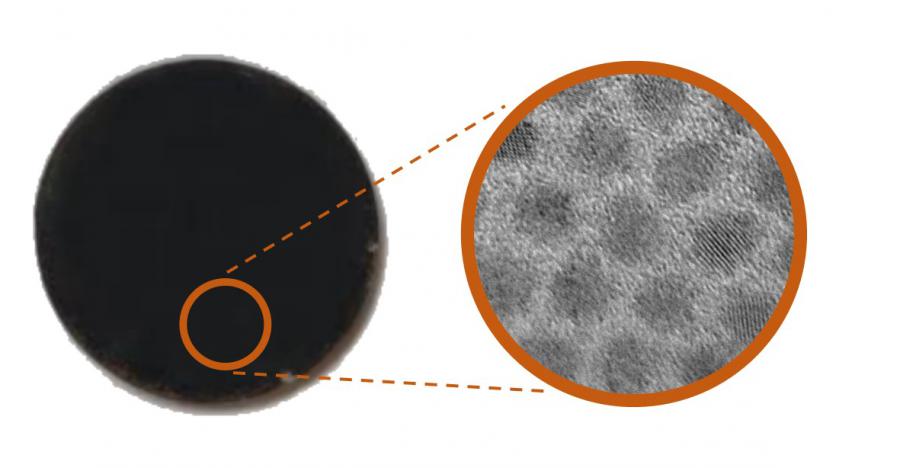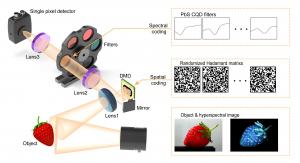
Quantum dot-enabled infrared hyperspectral imaging with single-pixel detection
USA, August 31, 2024 /EINPresswire.com/ -- This study suggests single-pixel detection as a cost-effective alternative to expensive InGaAs focal plane arrays (FPAs) for near infrared (NIR) hyperspectral imaging. It achieves successful imaging with colloidal quantum dots (CQDs) and a digital micromirror device (DMD) for multiplexing, offering a 600 nm detection window and 8.6 nm spectral resolution at 128 × 128 pixels. This method promises accessible and affordable NIR hyperspectral imaging, broadening its applications.
Near infrared (NIR) hyperspectral imaging is a highly promising detection technology capable of capturing detailed 3D spectral-spatial information, facilitating the identification and characterization of materials and targets based on their spectral signatures. Widely utilized across various industries such as chemistry, agriculture, and military, this technology relies on strategies like dispersive optics and narrow-band light filters. However, limitations exist in these approaches. Additionally, the fabrication of large-scale InGaAs detector arrays poses challenges, necessitating the development of new experimental methods and algorithms to advance infrared hyperspectral imaging technology in terms of miniaturization and cost-effectiveness.
In a recent paper (doi:https://doi.org/10.1038/s41377-024-01476-4 ) published in Light Science & Applications, a team led by Professor Baoqing Sun and Yuan Gao from Shandong University introduced a novel method for encoding near-infrared spectral and spatial data. Through the integration of self-assembled colloidal quantum dot (CQD) color filters and a digital micromirror device (DMD), they accomplished cooperative reconstruction of spectral and image data via single-pixel detection. Leveraging the tunable absorption curve of CQDs across a broad wavelength range, they engineered NIR filters based on the self-assembly structure of CQDs, controlled by surface characteristics and solution evaporation rate. The characteristic exciton absorption structure of CQDs' transmission spectral lines endowed them with greater spectral coding randomness and efficiency compared to traditional color filters. Employing CQDs and DMD for spectral and spatial information encoding, along with a single-pixel detector and compressed sensing algorithm, facilitated the association of the CQD filter's transmission spectrum with the projection pattern generated by the DMD. This enabled the acquisition of high-resolution NIR hyperspectral images. Each pixel, embodying a complete spectral feature, enabled the simultaneous reconstruction of spectrum and spatial dimension, rooted in the principle of single-pixel detection.
These scientists summarize their work:
“By combining a single-pixel detector with CQD filters, we eliminate the need for a costly 2D arrayed sensor typically employed in conventional hyperspectral imaging systems, thereby reducing system complexity and cost. The attained spectral reconstruction and spatial resolving capabilities showcase the effectiveness of our system and the promising potential for affordable and portable hyperspectral imaging devices.”
“Moreover, our strategy integrates both spectral and spatial encoding, potentially allowing for simultaneous and intertwined reconstruction of both spectra and images through the direct application of a compressed sensing algorithm on the hyperspectral data cube. This approach differs from applying the algorithm separately to spectral and spatial dimensions, offering the potential for a more efficient hyperspectral imaging process” they added.
DOI
10.1038/s41377-024-01476-4
Original Source URL
https://doi.org/10.1038/s41377-024-01476-4
Funding information
This work was financially supported by the National Natural Science Foundation of China (62205180), the Natural Science Foundation of Shandong Province (ZR2022QF029), the Taishan Scholar Program of Shandong Province (Young Scientist), and the Qilu Young Scientist Program of Shandong University.
Lucy Wang
BioDesign Research
email us here
Distribution channels: Science, Technology
Legal Disclaimer:
EIN Presswire provides this news content "as is" without warranty of any kind. We do not accept any responsibility or liability for the accuracy, content, images, videos, licenses, completeness, legality, or reliability of the information contained in this article. If you have any complaints or copyright issues related to this article, kindly contact the author above.
Submit your press release

